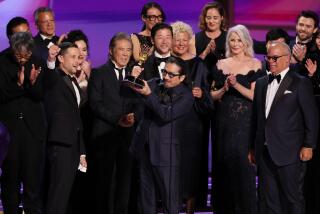How VFX Emmy nominees ‘Westworld,’ ‘Vikings’ and others transport TV audiences
There’s a new paradigm in television laced with high-end visual effects for a more sophisticated viewing audience. “Game of Thrones” has set the bar for the visual effects award, having won five of its previous six nominations. With its absence this year, having launched its seventh season too late for Emmy eligibility, the competitive VFX field has conjured the likes of pirate battles in 1715 Nassau and androids wandering a version of the Old West. Here, a quick chat with this year’s nominees.
Visual effects designer Kevin Haug and VFX supervisors David Stump and Jeremy Ball focused on photographic realism to develop the look and feel of Starz’s “American Gods” with director David Slade. “We tried desperately to make sure the visuals had a sense of photographic veracity so the VFX shots didn’t stick out in any way,” says Haug.
There were over 200 CG shots in the pilot, none of which used green screen, with the most difficult being the lucid dream sequences of Shadow Moon (Ricky Whittle). “We laid out so many different types of reality side by side in this episode – the exaggerated and humorous Vikings’ story, the subjective reality of Shadow doing time in prison, the looming supernatural, the deeper subconscious, and on top of all of that, we introduce a new modern mode of reality,” continues Haug. “In all, we were able to effectively create seven distinct environments that all worked together seamlessly.”
For senior VFX supervisor Erik Henry of “Black Sails,” an underwater sequence that pins John Silver (Luke Arnold) in a life or death situation became the focal point for episode “XXIX.” As the pirate drops to the ocean floor, he struggles to untangle his wooden leg from rigging. The camera floats past him to reveal the chaos above, where ships are sinking and bloody carnage seeps into the sea.
“The amount of detail to that scene took 20 weeks for us to complete,” Henry says. “You have boats getting hit by cannon fire and others streaking through the water – hundreds of bodies are swimming and the camera is 60 feet below. It’s a rich tapestry of detail shared between our live-action ships, full-scale sets and our visual effects crew who desire to make sure everything is accurate.”
In Amazon’s “The Man in the High Castle,” VFX supervisor Lawson Deming and the team brought to life the “Volkshalle,” an immense domed structure where Hitler would have held his rallies had Germany won World War II. “Extensive plans exist for it, and while we referenced them, the challenge was taking something kind of inherently unbelievable and making it not look artificial,” says Deming.
In the episode “Fallout,” the true nature of Hitler’s death is revealed inside the 1,000-foot-tall building where visual effects simulated a crowd of over 200,000 Germans and a large army, covering the sequence and speech from ranking officer John Smith (Rufus Sewell) with camera shots of the era as opposed to doing something too fancy.
The intense battle between Aethelwulf (Moe Dunford) and Ivar (Alex Høgh) on “Vikings” had visual effects led by VFX supervisor Dominic Remane turning 250 extras into several thousand soldiers for the episode “On the Eve.”
“It’s become a goal for us to dive into what makes a believable crowd,” says Remane. “Once we build its density, we find where the audience’s eye will be drawn and focus on adding tiny nuances to the people.” Instead of everyone doing similar actions, they’ll change a fighter’s running speed or switch one to be left-handed or add a shield or make someone trip. “When you watch it you’re never going to notice the differences, but when you keep watching, you’ll believe that it’s real.”
“Westworld” pushed the limits of practical filming to tell its story. “As a rule, visual effects are the flavor not the dish,” says VFX supervisor Jay Worth. “When it’s not possible in the natural world, that’s when we step in.” The challenge in “The Bicameral Mind” episode was creating the birth of Dolores (Evan Rachel Wood) where animatronics blended with her human form. “It needed to be robotic but elegant in a beautiful, realistic way,” he notes.
Host performances were manipulated slightly to enhance the robotic feel in diagnostic mode. When a host is waking up from a frozen slumber, VFX would remove three frames of their action or the team would add jerking, mechanical-like motions to simulate a host breaking down. “Our actors were incredible at embodying the role, the only time we changed something was story-dependent,” Worth says. “Sometimes we would take the smallest bit of sheen off their eyes so they would look less human.”
See the most read stories this hour »
More to Read
From the Oscars to the Emmys.
Get the Envelope newsletter for exclusive awards season coverage, behind-the-scenes stories from the Envelope podcast and columnist Glenn Whipp’s must-read analysis.
You may occasionally receive promotional content from the Los Angeles Times.







